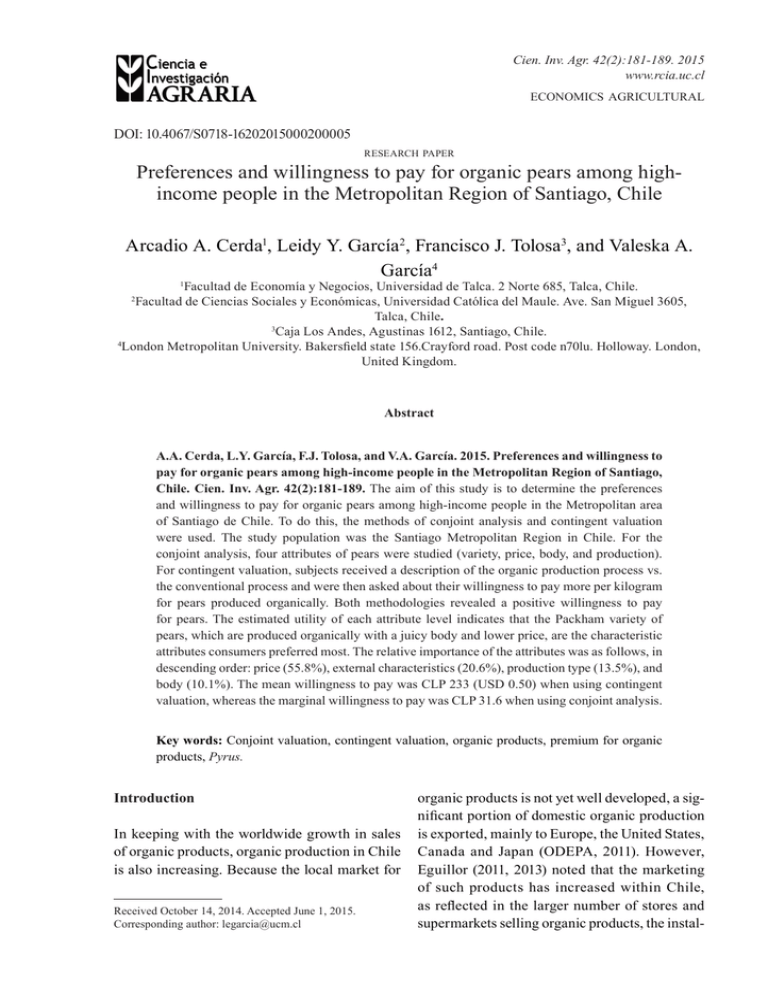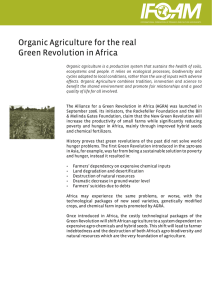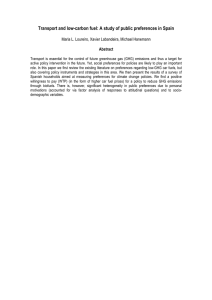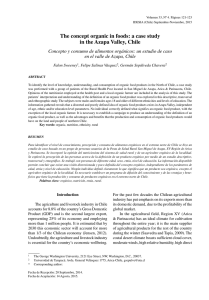Preferences and willingness to pay for organic pears among high
Anuncio

Cien. Inv. Agr. 42(2):181-189. 2015 www.rcia.uc.cl economics agricultural DOI: 10.4067/S0718-16202015000200005 research paper Preferences and willingness to pay for organic pears among highincome people in the Metropolitan Region of Santiago, Chile Arcadio A. Cerda1, Leidy Y. García2, Francisco J. Tolosa3, and Valeska A. García4 Facultad de Economía y Negocios, Universidad de Talca. 2 Norte 685, Talca, Chile. Facultad de Ciencias Sociales y Económicas, Universidad Católica del Maule. Ave. San Miguel 3605, Talca, Chile. 3 Caja Los Andes, Agustinas 1612, Santiago, Chile. 4 London Metropolitan University. Bakersfield state 156.Crayford road. Post code n70lu. Holloway. London, United Kingdom. 1 2 Abstract A.A. Cerda, L.Y. García, F.J. Tolosa, and V.A. García. 2015. Preferences and willingness to pay for organic pears among high-income people in the Metropolitan Region of Santiago, Chile. Cien. Inv. Agr. 42(2):181-189. The aim of this study is to determine the preferences and willingness to pay for organic pears among high-income people in the Metropolitan area of Santiago de Chile. To do this, the methods of conjoint analysis and contingent valuation were used. The study population was the Santiago Metropolitan Region in Chile. For the conjoint analysis, four attributes of pears were studied (variety, price, body, and production). For contingent valuation, subjects received a description of the organic production process vs. the conventional process and were then asked about their willingness to pay more per kilogram for pears produced organically. Both methodologies revealed a positive willingness to pay for pears. The estimated utility of each attribute level indicates that the Packham variety of pears, which are produced organically with a juicy body and lower price, are the characteristic attributes consumers preferred most. The relative importance of the attributes was as follows, in descending order: price (55.8%), external characteristics (20.6%), production type (13.5%), and body (10.1%). The mean willingness to pay was CLP 233 (USD 0.50) when using contingent valuation, whereas the marginal willingness to pay was CLP 31.6 when using conjoint analysis. Key words: Conjoint valuation, contingent valuation, organic products, premium for organic products, Pyrus. Introduction In keeping with the worldwide growth in sales of organic products, organic production in Chile is also increasing. Because the local market for Received October 14, 2014. Accepted June 1, 2015. Corresponding author: legarcia@ucm.cl organic products is not yet well developed, a significant portion of domestic organic production is exported, mainly to Europe, the United States, Canada and Japan (ODEPA, 2011). However, Eguillor (2011, 2013) noted that the marketing of such products has increased within Chile, as reflected in the larger number of stores and supermarkets selling organic products, the instal- 182 ciencia e investigación agraria lation of organic farmer’s markets, the growing amount of information and news articles about organic products, and the increase in the surface area dedicated to organic production. et al., 2007; Wang and Sun, 2003; Bradley and Geoffrey, 1999). Therefore, any study conducted on this subject should take into account mainly high-income consumers. Some reasons for the greater consumption of organic products include the perception that they are healthier, taste better and are safer, in addition to people’s lifestyles, in which factors associated with ecological issues are increasingly more important. For example, according to Adasme-Berrios et al. (2011) there are four constructs that boost consumption of organic products: the benefits of organic agriculture, healthy eating, lifestyles, and the attributes of organic products. The factors limiting consumption of new organic products in the market are low levels of consumer awareness, lack of distribution channels, and higher prices in comparison to conventional agricultural products. There has also been a great deal of variability in the results of the studies from Chile. Regarding apple consumption, price and variety are more important to consumer choices and behaviors than production method and taste. In the case of organic apples, there is an additional willingness to pay close to CLP 130 per kilogram, which represents a 22% greater WTP per kilogram than the average value of conventionally grown apples (Cerda et al., 2012). The study on table grapes found that the most preferred attributes of grapes, in order of importance, are sweet taste, organic production, seedlessness, and thin skin. Price, however, is the most important attribute in regard to choosing the type of grape (Cerda et al., 2011). As with grapes, price is the most important attribute of strawberries, followed by the red color of the berry, large size, organic production, and low price. This organic product has a WTP of CLP 43 per kilogram (Arce, 2010) above the normal price. Limited information exists about people’s preferences and willingness to pay (WTP) for organic agricultural products in Chile, in contrast to the large number of studies in developed countries (Nadezhda and Mazzocco, 2008; Boccaletti and Nardella, 2000; Baker, 1999). In Chile, several studies have been conducted on the production of organic apples (Cerda et al., 2012), table grapes (Cerda et al., 2011) and wine (Cerda et al. 2010). First, with regard to the Chilean studies, it is apparent that the individuals surveyed were chosen from all socioeconomic levels; second, the findings show high variability among the subjects with respect to the relative importance of the different attributes, as well as in the WTP for organic products (Cerda et al., 2012; Cerda et al., 2011; Arce 2010). A some studies, though, have shown that organic products tend to be purchased by people in high-income socioeconomic groups due to the higher prices of organics compared to conventional products (Cerda et al., 2014; Padilla Given the differences found by other authors with respect to the WTP for organic products and the variability of preferred attributes, it is important to study the WTP for pears. Additionally, given the high growth in the demand for organic products, it is important to know the preferences for organic pears as such knowledge can reveal new market opportunities for producers. The objective of the study is to estimate consumer WTP for organic pears and rank, by importance, the main attributes of this product for consumers. To obtain the WTP, the contingent valuation and conjoint analysis methods are used to identify and order the main attributes. The sample used is applied to high income people from the Metropolitan area of Santiago de Chile. 183 VOLUME 42 Nº2 MAY – AUGUST 2015 Materials and methods Study design This study uses data coming from a sample defined by convenience (Hair et al., 2003). The target population consists of men and women 18 years or older in the high socioeconomic level (ABC1: household income above CLP 1.7 million, equivalent to approximately USD 3,400) and residing in the Santiago Metropolitan Region of Chile, specifically from the area of the municipality of Ñuñoa, Providencia, Las Condes and Vitacura. Nine hypothetical scenarios were created in which the individuals interviewed received information about the organic production of goods. In this case, the following statement was presented to each individual: The organic pears are free of toxic waste products including persistent pesticides, synthetic fertilizers, antibiotics, additives and preservatives. These do not contain anabolic or hormones that can alter the biochemical balance of the body. The organic production system preserves the fertility of the land, and this takes care of the environment in a sustainable way. Additionally, the scenarios were accompanied by illustrative images of each product and its attributes, as described earlier. ing pears, reducing the need for a sensorial study. Additionally, a question regarding income level served as an initial interview filter to identify high-level income people. Instrument description The instrument has three main parts. The first part includes questions about an individual’s knowledge of organic products, places where one purchases pears and one’s preferences for different types of pears. This part also includes questions about the importance of organic products to the consumer and a description of the organic production method as mentioned above. The second part of the instrument contains questions about one’s willingness to pay for organic pears following a double-bound dichotomy choice. Additionally, this part also includes information about nine different profiles of pear characteristics (Table 1), considering different attribute levels. This information is required for the conjoint analysis, in which the attributes are ranked by the interviewees. The profiles are accompanied by photos of the different types of pears. The third part of the instrument includes a question about educational levels and gender. Table 1. Orthogonal design for pears, by attributes and levels. Card Price Variety (CLP) Body characteristic System of production Sampling procedure 1 1,050 Beurre Bosc Juicy Conventional 2 1,050 Winter Nellis Juicy Organic The measurement instrument was administered in-person to a total of 504 people between February 15, 2010 and March 30, 2010. A pre-sample was obtained using an open format with 50 people belonging to the highest income level (ABC1) from the Santiago Metropolitan Region to determine what variety of pears the interviewees regularly consume and the initial payment vectors, which were needed to build the payment vector in a double dichotomy format for a contingent valuation method. The instrument was only given to individuals with previous experience in consum- 3 875 Packham Juicy Organic 4 875 Winter Nellis Dry Conventional 5 875 Beurre Bosc Juicy Conventional 6 700 Winter Nellis Juicy Conventional 7 700 Packham Juicy Conventional 8 1,050 Packham Dry Conventional 9 700 Beurre Bosc Dry Organic CLP = Chilean pesos. CLP 700 is the market price for a kilogram of conventionally produced pears. CLP 850 is the average of the market price per kilogram of pears and the mean of the focus group. CLP 1,050 is the average price per kilogram of pears obtained in the focus group. 184 ciencia e investigación agraria Estimation methods To determine consumer WTP preferences, the conjoint analysis and contingent valuation methods were used. Both methods have been widely used in market research to analyze consumer preferences and WTP (Cerda et al., 2012; Markovina and Kovacic, 2008; Sánchez et al., 2001; Cerda et al., 2011; Gil et al., 2000; Aizaki and Sato, 2007). Conjoint analysis. Conjoint analysis is a method used in market research to determine consumer preferences for different product configurations, which is performed to estimate metric values (known as utilities) for each perceived characteristic. This method is also used to calculate consumer WTP for goods or services possessing certain attributes. Consumers evaluate the total utility, adding up the partial utility values for the various attributes (Green and Srinivasan, 1978). Although different scales can be used to determine preferences, the one most consistently used in consumer theory is the order of preferences (ranking). In this scale, individuals express their preferences for pears based on the attributes considered. The attributes were obtained through preliminary personal interviews and a bibliographic review, which ultimately yielded four attributes: variety (three levels), body (two levels), production (two levels), and price (three levels). To simplify the cumulative complexity among individuals’ choices, an orthogonal design was used to obtain a representative sample of profiles using SPSS (Statistical Product and Service Solutions. Inc. 2006. SPSS Categories Version 10.0, Chicago). This strategy resulted in only nine profiles (Table 1). In specifying the conjoint analysis model to be estimated, we opted for an additive preferences model to determine the part-worth utilities of each level of each attribute to obtain the total utility of a combination as expressed below (Bengochea et al., 2003; Steenkamp, 1987; Hair et al., 1999): 3 = 0 + ∑ =1 + 3 1, 1, + ∑ =1 2 2, 2 + ∑ =1 2 3, 3, + ∑ =1 4, 4, (1) where β1,i , is the partial utility of the price attribute associated with level i (i = 1,2,3), β2,j, is the partial utility of the variety attribute associated with variety j ( j = 1,2,3), β3,k is the partial utility of body attribute associated with level k (k = 1,2), and β4,p is the partial utility of the production attribute associated with level p (p = 1,2). The fictitious variables D1,i, D2,j, D3,k , D4,p, have a value of one if the level corresponding to the attribute is present and zero otherwise. Using the partial utilities of each person surveyed and to determine the consumer preference structure, we calculated the relative importance (I Ri) (Halbrendt et al., 1995; Hair et al., 1999) as follows: [ = 100 ∗ ℎ ](2) As a consequence, considering a linear preferences function, the WTP for a one-unit increase in the level of an attribute other than price can be obtained from the following expression: = − / (3) where βs the coefficient of the analyzed attribute s, and γ the price coefficient. Contingent valuation. Contingent valuation is a tool for estimating the value of goods or services when no market exists for them; so a hypothetical market is designed. We utilized Hanemann’s approach (Hanemann, 1984) regarding differences in the indirect utility function to estimate changes in the wellbeing and WTP of individuals when choosing to purchase a good (Cerda et al., 2007). To do this, a questionnaire is administered to potential consumers in which they are asked if they are willing to pay a specified amount of money for a hypothetical or existing good or service after having received a description of the product (Vásquez et al., 2007). The set of these values comprise what is known as the payment vector. 185 VOLUME 42 Nº2 MAY – AUGUST 2015 To obtain the payment vector for the contingent valuation, structured interviews were conducted on a pre-sample to obtain the necessary base values. The payment vector was then optimized by applying the routine proposed by Cooper (1993), using the DWEABS program (Cooper y Hellerstein, 1994). Ten payment vectors for organic pears were obtained, where the individuals expressed their additional WTP for a kilogram of organic pears vs. a kilogram produced conventionally. The estimations were based on Hanemann’s model (Hanemann, 1984), known as the “difference in the indirect utility function (Δvj).” To analyze the measures of wellbeing, the linear functional form of Hanemann et al. (1991) was used to estimate the WTP, yielding the following function: Δvj = α + βbi + η, where bi is the payment vector and η is the estimation error. The measure is the expectation of the true willingness to pay C, which can be calculated as E (C) = –α/β, where α is the coefficient of the constant term, and β is the coefficient of price. This was conducted in line with Cerda et al. (2012), where a logistic model was estimated using a likelihood method with the CVM Software (Cooper and Hellerstein, 1994), producing a logistic calculation for a double-bounded dichotomous choice contingent valuation method. method. The income distribution in this sample was 16.62% AB and 83.38% C1. In the sample used for estimation, 56.9% of the interviewees were female, and 43.1% were male. Broken down by age, 59.7% of the subjects were between 35 and 54 years old, with the lowest proportion being the group older than 65 years (0.85%). In terms of education level, 58.87% had obtained a higher education degree (four or five years of study) while 15.49% had not (Table 2). Table 2. Sample description. Variable % of the population Gender Female 56.9 Male 43.1 Age 18 to 24 4.23 25 to 34 18.03 35 to 44 27.32 45 to 54 32.39 55 to 64 17.18 Over 65 0.85 Household income CLP 1.700.000 to 3.499.999 (C1) 83.38 More than CLP 3.500.000 (AB) 16.62 Education level Results Descriptive analysis of the sample The questionnaires were administered to subjects within the AB level (household income above CLP 3.5 million, equivalent to about USD 7,000) or the C1 level (household income between CLP 1.7 million and CLP 3.5 million, equivalent to a range from USD 3,400 to almost USD 7,000) in the Santiago Metropolitan Region. Of the 504 interviews conducted with consumers of pears and apples, 355 valid questionnaires (correctly answered and meeting the study requirements) were obtained for use with the conjoint analysis High school incomplete 0.28 High school complete 5.63 Higher education incomplete 15.49 Higher education complete 58.87 Postgraduate incomplete 8.73 Postgraduate complete 10.99 The study was used to develop a profile of organic pear consumers as a function of the applied survey. Given that the study sample consisted of people in the ABC1 group, this sample primarily corresponds to women between the ages of 35 and 54 who were from a high socioeconomic level and completed a higher education degree. 186 ciencia e investigación agraria Conjoint analysis and consumer preferences for organic pears Using Kendall’s Tau statistic, we obtained values for the internal validity and predictive accuracy for pears in the order-of-preferences model (Hair et al., 1999). This statistic shows a strong correlation between estimated and observed preferences, and results verify a high predictive accuracy, as indicated by the value obtained for this statistic and its respective value (Table 3). Table 3. Estimation of utility by preference and scoring of pears. Preference (ranking) Attribute Level Variety Packham Beurre Bosc Winter Nellis 0.449 -0.232 -0.217 Body Juicy Dry 0.334 -0.334 Price 700 875 1050 -9.731 -12.164 -14.597 Production Conventional -0.442 Organic 0.442 (Constant) 12.300 Price coefficient -0.014 N 355 R of Pearson´s 0.9851 Kendall’s tau 1.0001 Value P = 0.000. 1 Results also indicate that the characteristic attributes that generate the greatest utility for consumers are pears of Packham Variety, with a juicy body, the lowest price (CLP 700, about USD 1.40) and that are organically produced. Additionally, a negative coefficient for the price attribute was observed, indicating consistency, such that utility increases as price decreases. The relative importance of the attributes to the consumers of pears in our sample were, in descending order, price, variety, production type, and body (Table 4). The findings of the conjoint analysis method indicate that consumers are willing to pay a surcharge of CLP 31.6 for a kilogram of organic pears. Table 4. Relative importance of attributes for the ranking model. Attribute Percentage Price 55.8 Variety 20.6 System of production 13.5 Body 10.1 Estimation of the contingent valuation model for organic pears On the subject of additional WTP for a kilogram of organic pears, 94% of the interviewees providing valid surveys said they would be willing to pay a surcharge for organic pears, although the amount of the acceptable surcharge varied. The primary reason given by the 6% of the sample for being unwilling to pay a surcharge was a lack of interest in organic pears. Table 5 presents the results of the model estimations, including the significant variables and their respective signs, which are consistent with economic theory. The β coefficient is negative because the higher the price, the lower the utility for the individual. For the same reason, a greater preference is expected for lower prices, showing that the probability that consumers will pay a higher price for organic pears is inversely proportional to their value. The WTP calculated was CLP 233.4, which translates to approximately USD 0.50. Table 5. Estimation of the contingent valuation model for organic pears. Variable Coefficient Constant = α 5.62282 0.37821 Payment vector = β -0.02412 (0.0015)1 Logarithmic probability -25.65282 Mean WTP CLP 233.4 99% confidence interval 219.0 to 248.0 N 2623 Standard error. All significant coefficients at 1%. Value P = 0.0001. 3 Sub-sample with positive WTP for all surveyed. 1 2 VOLUME 42 Nº2 MAY – AUGUST 2015 Discussion Both methods, contingent valuation and conjoint analysis, generated somewhat similar results with consistent estimations, indicating that the interviewees do have an additional WTP for organic pears. However, the WTP found through contingent valuation is higher than that found through conjoint analysis. This positive WTP for organic products coincides with other studies such as Gil et al. (2000) and Montoro and Castañeda (2005). This surcharge obtained for organic pears was approximately 30% of the current price for conventionally produced pears. This percentage is in line with the surcharge calculated for organic products in the studies conducted by Montoro and Castañeda (2005) and Giacinti (2004). When the findings are compared to results obtained for organic strawberries and table grapes by Arce (2010), Cerda et al. (2012) and Cerda et al. (2011), it is evident that the calculated WTPs vary considerably among different types of fruit. This variability reflects personal preferences for fruit, which is in line with the studies conducted by Lacaze (2009). In addition, the estimated utility of each attribute level indicates that the Packham variety, organic production, a juicy body, and a lower price are the attributes that consumers prefer most. Nevertheless, analysis of the relative importance of each attribute shows that price and variety are the most significant attributes considered in consumer decision-making while production method and body are less significant. In accordance with findings from the studies of organic grapes, apples, and strawberries (Cerda, 2011; Cerda 2012; Arce, 2010), despite observed 187 differences in preferences for certain attributes, price continues to be the most important factor in determining preferences. The organic production method is ranked as the third most important factor in three of the four studies conducted in Chile (including this one), with relatively low levels of importance. The information about consumers’ preferences as well as the price premium that they are willing to pay for organic products provides an opportunity for producers of pears to evaluate the convenience and complexity in reaching out to a new market segment. At a minimum, producers should compare the expected change in productivity with the change in price to determine the profitability of producing organic pears. Indirectly, the positive preferences and willingness to pay for organic products among high-income people, as in this study, are signals to policy makers about the need to implement incentives or regulations toward a more sustainable agricultural economy with respect to organic foods. Therefore, further studies should be conducted to compare the WTP and preferences for additional types of organic fruits while focusing on higher income people to examine the variability in values for the WPT between goods produced organically and those produced conventionally. Acknowledgments We are grateful for support received from the Program for Interdisciplinary Research Excellence for Agricultural Adaptation to Climate Change, PIEI-A2C2, Universidad de Talca, Chile. 188 ciencia e investigación agraria Resumen A.A. Cerda, L.Y. García, F.J. Tolosa y V.A. García. 2015. Preferencias y disposición a pagar por peras orgánicas, en la Región Metropolitana de Santiago, Chile. Cien. Inv. Agr. 42(2):181-189. El presente estudio tiene como objetivo determinar las preferencias y la disposición a pagar por peras orgánicas. Para ello se utilizó el método de análisis conjunto y valoración contingente. La población de estudio fue la región Metropolitana de Santiago de Chile, donde se encuestaron 504 individuos. Para el análisis conjunto se utilizaron cuatro atributos (variedad, precio, cuerpo y producción) de la pera, y para la valoración contingente se describió la situación de producción orgánica versus convencional donde se preguntaba la disposición a pagar adicional por kilo de peras. Como resultado de ambas metodologías utilizadas se obtuvo una disposición a pagar positiva por peras producidas orgánicamente. La estimación de las utilidades de cada atributo indica que las características como variedad Pakhma’s, método producción orgánica, cuerpo jugoso y precio más bajo, son los que tienen mayor preferencia por parte de los consumidores. La importancia relativa de los atributos son, por orden de importancia, precio (55,8%), variedad (20,6%), tipo de producción (13,5%) y cuerpo (10,1%). La disposición a pagar media alcanza a 233 pesos usando valoración contingente mientras que la marginal alcanza 31,6 pesos chilenos, usando análisis conjunto. Palabras clave: Análisis conjunto, prima por productos orgánicos, productos orgánicos, Pyrus, valoración contingente. References Adasme-Berrios, C., M. Rodríguez, R. Jara-Rojas, and B. Díaz-Tobar. 2011. Dimensiones que caracterizan el consumo potencial de alimentos orgánicos en la Región del Maule, Chile. Rev. Fac. Cienc. Agrar. UNCuyo 43: 59-69. Aizaki, H., and N. Sato. 2007. Consumers’ valuation of good agricultural practice by using contingent valuation and contingent ranking methods: Acase study of Miyagi prefecture, Japan. Agricultural Information Research 16: 150-157. Baker, G.A. 1999. Consumer preferences for food safety attributes in fresh apples: market segments, consumer characteristics, and marketing opportunities. Journal of Agricultural and Resource Economics 24: 80-97. Bengochea, A., A. Fuertes, and S. Del Saz. 2003. Estudio de las preferencias individuales sobre un espacio natural mediante el análisis conjunto. Instituto Valenciano de Investigaciones Económicas, S.A. Primera Edición Mayo. Boccaletti, S., and M. Nardella. 2000. Consumer willingness to pay for pesticide-free fresh fruit and vegetables in Italy. International Food and Agribusiness Management Review 3: 297310. Bradley, J., and S. Geoffrey. 1999. Protest responses and willingness to pay: attitude toward paying for storm water pollution abatement. Ecological Economics 33: 251–65. Cerda, A., L. García, J. Tolosa, and V. García. 2014. Preferencias y disposición a pagar por manzanas orgánicas en la Región Metropolitana de Santiago de Chile. Rev. Fac. Agron. (LUZ) 31:2754-289. Cerda, A. L. García, S. Ortega-Farias, and A. Ubilla. 2012. Consumers preferences and willingness to pay for organic apples. Cien. Inv. Agr. 39:47-39. Cerda, A., L. García, J. González, and A. Salvatierra. 2011. Preferências e disposição de pagar por uvas de mesa orgânica na região do Maule, Chile. Rev. Bras de Frutic. 33: 784-790. Cerda, A., M. Torres, and L. García. 2010. Preferences and Willingness to pay for ecological wine from the Maule region´s consumers, Chile. Panorama Socioeconómico 26(40): 60-71. Cerda, A., J. Rojas, and L. García. 2007. Disposición a pagar por un mejoramiento en la calidad ambiental en el Gran Santiago. Lecturas de Economía 67: 143-160. Cooper, J. 1993. Optimal bid selection for dichotomous choice contingent valuation surveys. Journal of Environmental Economics and Management 24: 25-40. VOLUME 42 Nº2 MAY – AUGUST 2015 Cooper, J., and D. Hellerstein. 1994. CVM Software. USDA/ERS/Resources and Technology Division, Washington DC, 20005-4788. Eguillor, P. 2011. Mercados Agropecuarios. Oficina de Estudios y Políticas Agrarias (ODEPA), N°224, marzo. Santiago, Chile. Available online at: www.odepa.gob.cl (Website January, 2015). Eguillor, P. 2013. Agricultura orgánica. Temporada 2011-2012. Oficina de Estudios y Políticas Agrarias (ODEPA), abril. Santiago, Chile. Available online at: www.odepa.gob.cl (Website January, 2015). Giacinti, M. 2004. Visión mundial de las frutas con calidad diferenciada: producción integrada y orgánica. Cuadernos del CEAgro 6:51-60. Gil, J., A. Gracia., and M. Sánchez. 2000. Market segmentation and willingness to pay for organic products in Spain. International Food and Agribusiness Management Review 2: 207-2 6. Green, P., and V. Srinivasan. 1978. Conjoint analysis in consumer research: issues and outlook. J. Cons. Res. 5: 103-123. Hair, J. Bush, R., and Ortinau, D. 2003. Investigación de mercados. México. McGrawHill. Segunda edición. Mexico D.F., Mexico. 678 pp. Hair, J., R. Anderson, R. Tathan, and W. Black.1999. Análisis Multivariante. Quinta Edición. Prenticehall. Iberia, Madrid, España. 822 pp. Halbrendt, C., Q. Wang, C. Fraiz, and L. O´Dierno. 1995. Marketing problems and opportunities in Mid Atlantic sea food retailing. American Journal of Agricultural Economics 77: 1313-1318. Hanemann, W.M. 1984. Welfare evaluation in contingent valuation experiments with discrete response. American Journal of Agricultural Economics 66: 332-341. Hanemann, W.M. 1991. Willingness to pay and willingness to accept: How much can they differ?. American Economic Review 81: 635–647. Lacaze, V. 2009. Las Preferencias de los Consumidores Argentinos por Alimentos diferenciados por Atributos de Calidad de Procesos: El Caso de la Leche Entera Orgánica. Rev. Economía Agrícola, Sao Paulo 56: 73-88. Markovina, J. and D. Kovacic. 2008. The Importance of Apple attributes: a Comparison of Self-expli- 189 cated and Conjoint Analysis Results. In: 12th EAAE Congress ‘People, Food and Environments: Global Trends and European Strategies’. Gent, Belgium. 26-29 August. Montoro, F., and J. Castañeda. 2005. Determinantes dela disposición a pagar un sobreprecio por producto de agricultura ecológica. Cuadernos de CC.EE y EE. 49:95-114. Nadezhda, K., and M. Mazzocco. 2008. Consumer preferences and trade-offs for locally grown and genetically modified apples: a Conjoint analysis approach. International Food and Agribusiness Management Review 11(4): 31-53. ODEPA- Oficina de Estudios y Políticas Agrarias. 2011. Propuesta de plan estratégico para la agricultura orgánica chilena 2010-2020. Oficina de Estudios y Políticas Agrarias. Available online at: http://www.agriculturaorganicaamericas. net/Regiones/Sur/Chile/Documentos%20CIAO/ Plan_Estrategico_Agricultura_Organica%20 ODEPA%202010-2020.pdf (Website accessed: January 30, 2011). Padilla, C., P. Villalobos, A. Spiller, and G. Henry. 2007. Preferencias y disposición del consumidor a pagar por un sello de calidad certificada para productos de alimentos de origen campesino. Agric. Téc. 67:300-308. Sánchez, G., I. Grande, J. Gil., and A. Gracia. 2001. Diferencias entre los segmentos del mercado en la disposición a pagar por un alimento ecológico: valoración contingente y análisis conjunto. Estudios Agrosociales y Pesqueros 190: 141163. Steenkamp, J. 1987. Conjoint measurement in ham quality evaluation. Journal of Agricultural Economics 38: 473-480. Vásquez, F., A. Cerda, and S. Orrego. 2007. Valoración económica del ambiente. Fundamentos económicos, econométricos y aplicaciones. Thomson Learning. Buenos Aires, Argentina. 368 pp. Wang, Q., and J. Sun. 2003. Consumer`s preferences and demand for organic food: evidence from a Vermont survey. American Agricultural Economics Association Annual Meeting, Montreal, Canada. p. 12.





